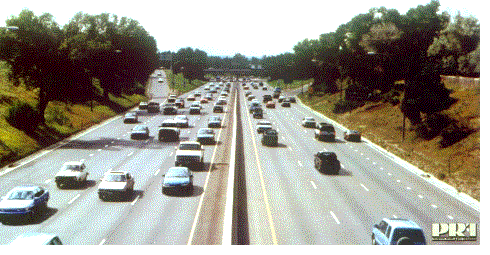SkyTran Solution to Highway Congestion
This animation shows highway congestion caused by cars and how SkyTran alleviates it.
Frame 1 shows lots of cars on the highway.
Frame 2 shows just the cargo of importance - the
people!
If you change your perspective to thinking about the real problem of moving
just the people around to wherever they want to go whenever they
want to go, then engineering solutions to congestion start to become
apparent!
Ask yourself why are those cars so big?
Does it really require a 3,000 pound or larger mobile structure to move the average 170 pound adult from place to place?Next ask yourself why do most of the cars have only one person in them during rush hour congestion?
Commuters obviously place a high value on their choice of personal flexibility.
How often do two people want to leave from the same location to go to the same destination, let alone want to do it at the exact same time?
Personal flexibility is the prime reason why car pool lanes have never been successful in getting people to ride to work together.
It is too inconvenient.
So, if commuters want to ride alone, why not create more appropriately sized vehicles for them?
Frame 3 shows all the important human
"cargo" moved to the center median.
The road is now completely empty!
Frame 4 shows the same number of people being driven to their destinations in automated personal sized vehicles. The solution to modern congestion is closely packed, high speed, small individual vehicles moving in automatic synchronization with each other. Autonomous, high speed, track guided passenger vehicles using low cost high speed computers and sensors can eliminate road congestion. Note that one small unobtrusive SkyTran bi-directional guideway can carry the equivalent of 6 lanes of highway passenger traffic when ridden solo (12 highway lanes if ridden dual)!
This
animated sequence* could have yet another frame:
much of the road can now be converted to a park!
In the early pioneer days, before internal combustion powered automobiles were invented, families used their multi-passenger horse drawn buckboard primarily to go to church on Sunday and for family group visits. When you went somewhere yourself, you didn't hook the horse up to the buckboard, you threw a saddle on the horse and rode that more personal sized transportation! We need to start thinking along those minimalist lines again.
Have you ever wondered why people who already own one car big enough to carry their entire family continue to purchase second and third cars that are also big enough to carry the entire family? Why don't they all buy little 100 mpg personal sized cars in which to commute alone back and forth to work instead of those additional large vehicles? Then twice as many n any given highway (think motorcycle sized vehicles that had full bodies, creature comforts and four wheels instead of two).
If all commuters drove this smaller form of vehicle to work, then the morning and evening rush hour congestion and current crawling along in bunches of big cars would be eliminated. This is simply because the current width highway lane could carry twice as many vehicles side by side. Unfortunately, there are two logical reasons why that scenario won't happen. No one is selling such vehicles now, and if they started, personal safety in the interim (before such small 500 pound vehicles dominated the landscape) would be worse. Especially consider the 80,000 pound tractor-trailer trucks that the 3,000 pound cars currently share the roads with. A big rig truck always wins in a collision with a car.
The realistic way to eliminate congestion as we know it is SkyTran technology. Non-stop, high speed commuting featuring unprecedented safety. SkyTran is a non-polluting, clean, electric powered, go everywhere, on-demand, personalized transit system. All it takes is modern computers, modern sensor and control systems, light-weight aerodynamic structures, and the economies of scale available with modern factory automation.
